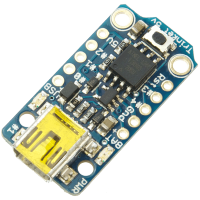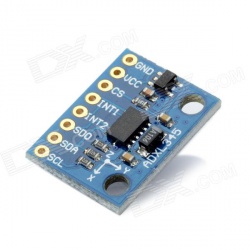ATtiny85 8MHz and ADXL345 via I2C with Arduino code
This is a small setup based on the ATtiny85 to make use of the advanced features of the ADXL345 accelerometer.
Parts
- Adafruit Trinket 3V ATtiny85 board
- No need for level shifting for ADXL345 I2C
- Comes with [Trinket Bootloader] to upload binary with USB during the first 10 seconds of power-up/reset
- Red LED on #1/PB1 is handy for debugging
- GY-291 ADXL345 Digital 3-Axis accelerometer breakout
- On-board 3.3V LDO for ADXL345
- I2C 4.7k pull-ups
- CS 4.7k pull-up - enable I2C, not SPI
- SDO 4.7k pull-down - I2C address 0x53
- Comes with 2.54mm pin header
Wiring
- ATtiny -> ADXL345
- USB (point) -> VCC
- GND -> GND
- #0/PB0 -> SDA
- #2/PB2 -> SCL
Libraries
- TinyWireM - Using the USI on ATtiny to emulate TWI/I2C, improved by Adafruit
Speed
Add this section to the hardware.txt in the attiny folder to enable 1MHz and 4MHz processing speed.
trinket1.name=Adafruit Trinket 1MHz
trinket1.bootloader.low_fuses=0xF1
trinket1.bootloader.high_fuses=0xD5
trinket1.bootloader.extended_fuses=0xFE
trinket1.upload.maximum_size=5310
trinket1.build.mcu=attiny85
trinket1.build.f_cpu=1000000L
trinket1.build.core=arduino:arduino
trinket1.build.variant=tiny8
trinket2.name=Adafruit Trinket 4MHz
trinket2.bootloader.low_fuses=0xF1
trinket2.bootloader.high_fuses=0xD5
trinket2.bootloader.extended_fuses=0xFE
trinket2.upload.maximum_size=5310
trinket2.build.mcu=attiny85
trinket2.build.f_cpu=4000000L
trinket2.build.core=arduino:arduino
trinket2.build.variant=tiny8
Code
arduino_adxl345.ino:
/* ATtiny85 and ADXL345 demo code
by ivc <ivc at x-pec.com> 2015
This sensor test will enable the red LED on the Trinket board when the y-axis is positive, e.g. tilted to one side, and turn
off when tilted the other way.
The TWI/I2C speed is determined by the F_CPU speed selected during compiling (Tools -> Board -> Adafruit Trinket 1/8/16MHz).
Due to inherent instability of the internal RC oscillator in the ATtiny, 8MHz does not always work - try 1MHz. Also, a pull-up
higher than 4.7K Ohm will introduce slew on the rising edge, causing the signal fail to be recognized. Try 2K Ohm pull-ups
on 3.3V setups, and 4.7K on 5V (3.3V/1.5mA = 2K Ohm).
Beware: ADXL345 sensor can easily be damaged if handled improperly. Always keep a couple extras to swap out and for testing.
*/
#include <TinyWireM.h>
#include <avr/power.h>
float x, y, z;
void setup(void)
{
// Dynamically change processing speed - use Tools -> Board -> Adafruit Trinket 1/8/16MHz to adjust
if (F_CPU == 16000000) { clock_prescale_set(clock_div_1);
} else if (F_CPU == 8000000) { clock_prescale_set(clock_div_1);
} else if (F_CPU == 4000000) { clock_prescale_set(clock_div_2);
} else if (F_CPU == 2000000) { clock_prescale_set(clock_div_4);
} else if (F_CPU == 1000000) { clock_prescale_set(clock_div_8); }
// On-board Red LED
pinMode(PB1, OUTPUT);
digitalWrite(PB1, LOW);
// Setup ADXL345
adxl345_init();
}
void loop(void)
{
// Update accelerometer values
readAccel(&x, &y, &z);
// Enable LED of tilted over mid-point
if (x > 0) digitalWrite(PB1, HIGH);
else digitalWrite(PB1, LOW);
// Wait a small period to update
delay(100);
}
adxl345_sensor.ino:
/************************************************************************
* This program is free software; you can redistribute it and/or modify *
* it under the terms of the GNU License V2. *
* This program is distributed in the hope that it will be useful, *
* but WITHOUT ANY WARRANTY; without even the implied warranty of *
* MERCHANTABILITY or FITNESS FOR A PARTICULAR PURPOSE. See the *
* GNU General Public License, version 2 for more details *
* *
* Bare bones ADXL345 i2c example for Arduino 1.0 *
* by Jens C Brynildsen <http://www.flashgamer.com> *
* This version is not reliant of any external lib *
* (Adapted for Arduino 1.0 from http://code.google.com/p/adxl345driver)*
* *
* Demonstrates use of ADXL345 (using the Sparkfun ADXL345 breakout) *
* with i2c communication. Datasheet: *
* http://www.sparkfun.com/datasheets/Sensors/Accelerometer/ADXL345.pdf *
* If you need more advanced features such as freefall and tap *
* detection, check out: *
* https://github.com/jenschr/Arduino-libraries *
***********************************************************************/
#include <TinyWireM.h>
#define DEVICE (0x53) // Device address as specified in datasheet
#define SENSORS_GRAVITY_STANDARD (9.80665F) // Const float
#define MG2G_MULTIPLIER (0.004) // 4mg/LSB
byte _buff[2]; // Buffer array
char POWER_CTL = 0x2D; //Power Control Register
char DATA_FORMAT = 0x31; // Data format control
char DATAX0 = 0x32; // X-Axis Data 0
char DATAX1 = 0x33; // X-Axis Data 1
char DATAY0 = 0x34; // Y-Axis Data 0
char DATAY1 = 0x35; // Y-Axis Data 1
char DATAZ0 = 0x36; // Z-Axis Data 0
char DATAZ1 = 0x37; // Z-Axis Data 1
char BW_RATE = 0x2C; // Data rate and power mode control
void adxl345_init()
{
TinyWireM.begin(); // Join i2c bus (address optional for master)
// Setup ADXL345 registers, see datahsheet to configure for your liking
writeTo(DATA_FORMAT, B00000000); // Enable most sensitive 2g range, B1B0
writeTo(BW_RATE, B00001100); // Set 400Hz output update rate - not I2C but data output, B4B3B2B1
writeTo(POWER_CTL, 0); // Always be sure to zero out register, don't asume it's zero
writeTo(POWER_CTL, B00001000); // Enter measurement mode, B4
}
void readAccel(float *x, float *y, float *z)
{
// How many bytes to request from ADXL345 - it seems there are problems doing more than 4 bytes, keep it at 2 bytes.
// Z-axis DATAZ1 register is sometimes is bad, only first DATAZ1 register return valid data
uint8_t howManyBytesToRead = 2;
// Zero buffer array
memset(_buff, 0, 6);
// Each axis reading comes in 10 bit resolution, i.e. 2 bytes, least significat byte first!!
// Thus we are converting both bytes in to one int - shift bytes to align like DATAX1DATAX0
// If the bytes seem switched from the sensor, change [1] to [0] and verse visa
readFrom( DATAX0, howManyBytesToRead, _buff); //read the acceleration data from the ADXL345
*x = ((((int)_buff[0]) << 8) | _buff[1]) * MG2G_MULTIPLIER * SENSORS_GRAVITY_STANDARD;
// Zero buffer array
memset(_buff, 0, 6);
readFrom( DATAY0, howManyBytesToRead, _buff); //read the acceleration data from the ADXL345
*y = ((((int)_buff[0]) << 8) | _buff[1]) * MG2G_MULTIPLIER * SENSORS_GRAVITY_STANDARD;
// Zero buffer array
memset(_buff, 0, 6);
readFrom( DATAZ0, howManyBytesToRead, _buff); //read the acceleration data from the ADXL345
*z = ((((int)_buff[1]) << 8) | _buff[0]) * MG2G_MULTIPLIER * SENSORS_GRAVITY_STANDARD;
// Test single bit
//if ( (_buff[0] & 0B10000000) ) digitalWrite(PB1, HIGH);
//else digitalWrite(PB1, LOW);
}
// Write vale to register address
void writeTo(byte address, byte val) {
TinyWireM.beginTransmission(DEVICE); // start transmission to device
TinyWireM.write(address); // send register address
TinyWireM.write(val); // send value to write
TinyWireM.endTransmission(); // end transmission
}
// Reads num bytes starting from address register on device in to _buff array
void readFrom(byte address, int num, byte _buff[]) {
TinyWireM.beginTransmission(DEVICE); // start transmission to device
TinyWireM.write(address); // sends address to read from
TinyWireM.endTransmission(); // end transmission
//TinyWireM.beginTransmission(DEVICE); // start transmission to device
TinyWireM.requestFrom(DEVICE, num); // request 6 bytes from device
int i = 0;
while(TinyWireM.available()) // device may send less than requested (abnormal)
{
_buff[i] = TinyWireM.read(); // receive a byte
i++;
}
//TinyWireM.endTransmission(); // end transmission
}

